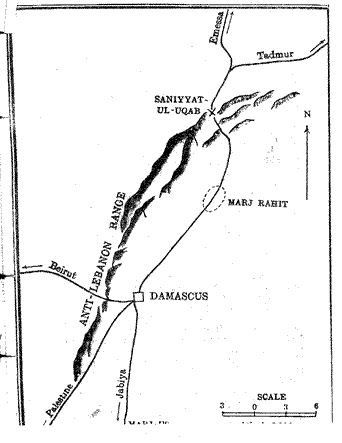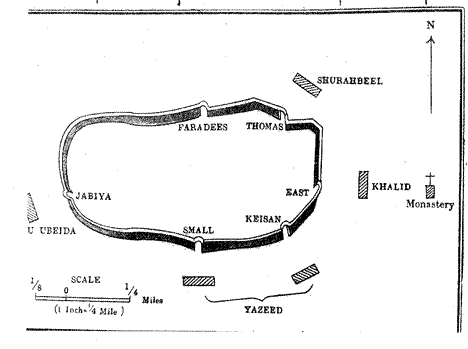|
The Romans stood firm for
an hour or so, but could not hold the Muslims longer. The loss of
a large number of their officers, including the two top generals,
had had a depressing effect on their spirits; and the fact that
Damascus stood just behind, beckoning to them to come and be safe
within its walls acted as a temptation to withdraw. So they retreated,
in good order, leaving behind a large number of dead. The Roman
army arrived at the city and entered its walls, closing the gates
behind it.
The Muslims spent the night on the plain,
and the following day marched to the city. Here, on August 20, 634
(the 20th of Jamadi-ul-Akhir, 13 Hijri), Khalid launched the Muslim
army into the siege of Damascus. 1
Khalid had already left behind a mounted
detachment at Fahl to keep the Roman garrison occupied and prevent
it from coming to the aid of Damascus or interfering with the movement
of messengers and reinforcements from Madinah. Now he sent out another
detachment on the road to Emessa to take up a position near Bait
Lihya, about 10 miles from the city, 2 and
instructed its commander to send out scouts to observe and report
the arrival of Roman relief columns. If unable to deal with such
columns himself, the detachment commander would seek Khalid's help.
Having thus arranged a blocking position to isolate Damascus from
Northern Syria, which was the most likely region whence relief columns
could approach Damascus, Khalid surrounded the city with the rest
of the army (See Map 17 below).

Damascus now held a Roman garrison of about
15,000 to 16,000 soldiers, a considerable civil population comprising
the permanent inhabitants and a large number of people from the
surrounding region who had taken refuge in the city. The Muslim
strength at Damascus is not recorded, but must have been quite a
bit less than in the preceding month. Muslim dead in the three battles
just fought - at Ajnadein, at Yaqusa and at the Marj-us-Suffar -
undoubtedly ran into four figures; and thousands more must have
been wounded in these battles and rendered unable to participate
in the siege. Moreover, a group had been sent out as a blocking
force and a detachment left at Fahl. In view of all this, I estimate
the Muslim strength at Damascus at about 20,000 men. With this strength
Khalid besieged the city.
He positioned the corps of Iraq, which included
elements of the Mobile Guard, at the East Gate. He placed the bulk
of this corps under Raafe, and himself stayed a short distance away
from the East Gate with a reserve of 400 horsemen from the Mobile
Guard. He established his headquarters in a monastery which, as
a result, became known as Dair Khalid, i.e. Monastery of Khalid
(and it is believed that the monks living in this monastery helped
the Muslims in various ways, including the care of the Muslim wounded).
3 At each of the remaining gates, he deployed
a force of 4,000 to 5,000 men whose commanders were as follows (See
Map 18 below):
Gate of Thomas : Shurahbil,
Jabiya Gate : Abu Ubaidah,
Gate of Faradees : Amr bin Al Aas,
Keisan Gate : Yazeed,
Small Gate : Yazeed.

To the corps commanders Khalid gave instructions
to the effect that they would: (a) camp outside bow-range of the
fort; (b) keep the gate under observation; (c) move archers up to
engage any Roman archers who appeared on the battlements; (d) throw
back any Roman force which sallied out from the gate; and (e) seek
Khalid's help in case of heavy pressure. Dhiraar was placed in command
of 2,000 horsemen from the Mobile Guard, and given the task of patrolling
the empty spaces between the gates during the night and helping
any corps attacked by the Romans.
With these instructions the Muslim corps
deployed, and the siege began. Tents were pitched, and Dhiraar started
his patrolling. Every main avenue of relief and escape was closed,
but this applied only to formed bodies of men. Individuals could
still be lowered from the wall at many places during the night,
and thus Thomas was able to keep in touch with the outside world
and with Heraclius at Antioch.
1. For an explanation of the details of
the Battle of Marj-us-Suffar, see Note 10 in Appendix B.
2. Bait Lihya no longer exists, and its exact
location is not known. It was a small town in the Ghuta (Yaqut:
Vol. 1, p. 780), and I have placed it at the outer edge of the Ghuta
because to position a blocking force nearer the city would be militarily
unsound.
3. This monastery, which was also known as
Dair-ul-Ahmar (the Red Monastery), no longer exists, but its general
location is known. About a quarter of a mile from the East Gate,
stretching eastwards, stands a garden. The monastery was in this
garden, and according to Waqidi (p. 43), was less than half a mile
from the gate.
|
